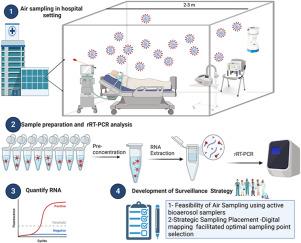Indoor air sampling strategies by active bioaerosol samplers: a case study to detect SARS-CoV-2 in hospital settings
IF 2.9
3区 环境科学与生态学
Q2 ENGINEERING, CHEMICAL
引用次数: 0
Abstract
This study demonstrates the applicability of air sampling for the detection of SARS-CoV-2 in a hospital by means of active bioaerosol samplers following a specifically designed air sampling strategy based on digital mapping of the architectural layout of the ward to minimize disruptions of health care activities and reducing operator risks. Prior to the experimental study, some model tests were conducted using the air sampler with a tunable flow rate to determine the most suitable real time polymerase chain reaction (RT-PCR) based detection method. Preliminary results showed the need to perform intensive extraction protocols combined with Real-time reverse transcription PCR (rRT-PCR), rather than conventional, to enhance sensitivity. The experimental study was conducted within the general medicine ward of Spedali Civili Hospital in Brescia during the winter of 2021/2022, a period marked by a high prevalence of COVID-19 cases using three active air sampling devices: Coriolis Compact®, Coriolis Micro®, and BioSpot GEM®. Environmental parameters, such as room size, occupancy, ventilation rates, and activities performed during sampling, and patients’ conditions were documented to contextualize the findings. The virus was detected in a few rooms with concentrations ranging from 1171 to 2225 copies/m3. These findings support the integration of routinary air sampling as tools for control and assessment of transmission risks, not only for SARS-CoV-2 but generalized to all airborne pathogens, supporting patient management and infection control in health care settings.

主动生物气溶胶采样器的室内空气采样策略:在医院环境中检测SARS-CoV-2的案例研究
本研究证明了空气采样在医院中检测SARS-CoV-2的适用性,通过主动生物气溶胶采样器,遵循基于病房建筑布局的数字测绘的专门设计的空气采样策略,以最大限度地减少卫生保健活动的中断并降低操作人员的风险。在实验研究之前,使用可调流量的空气采样器进行了一些模型试验,以确定最适合的基于实时聚合酶链反应(RT-PCR)的检测方法。初步结果表明,需要执行密集的提取方案,结合实时反转录PCR (rRT-PCR),而不是传统的,以提高灵敏度。实验研究于2021/2022年冬季在布雷西亚Spedali Civili医院的普通内科病房进行,这是COVID-19病例高流行的时期,使用了三种主动空气采样装置:Coriolis Compact®、Coriolis Micro®和BioSpot GEM®。环境参数,如房间大小,占用率,通风率,在采样期间进行的活动,以及患者的情况被记录下来,以使研究结果背景化。在几个房间检测到病毒,浓度在1171至2225份/立方米之间。这些发现支持将常规空气采样整合为控制和评估传播风险的工具,不仅适用于SARS-CoV-2,而且适用于所有空气传播病原体,从而支持卫生保健机构的患者管理和感染控制。
本文章由计算机程序翻译,如有差异,请以英文原文为准。
求助全文
约1分钟内获得全文
求助全文
来源期刊

Journal of Aerosol Science
环境科学-工程:化工
CiteScore
8.80
自引率
8.90%
发文量
127
审稿时长
35 days
期刊介绍:
Founded in 1970, the Journal of Aerosol Science considers itself the prime vehicle for the publication of original work as well as reviews related to fundamental and applied aerosol research, as well as aerosol instrumentation. Its content is directed at scientists working in engineering disciplines, as well as physics, chemistry, and environmental sciences.
The editors welcome submissions of papers describing recent experimental, numerical, and theoretical research related to the following topics:
1. Fundamental Aerosol Science.
2. Applied Aerosol Science.
3. Instrumentation & Measurement Methods.
 求助内容:
求助内容: 应助结果提醒方式:
应助结果提醒方式:


